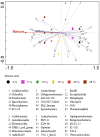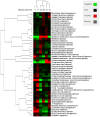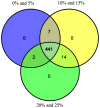Manure refinement affects apple rhizosphere bacterial community structure: a study in sandy soil
- PMID: 24155909
- PMCID: PMC3796563
- DOI: 10.1371/journal.pone.0076937
Manure refinement affects apple rhizosphere bacterial community structure: a study in sandy soil
Abstract
We used DNA-based pyrosequencing to characterize the bacterial community structure of the sandy soil of an apple orchard with different manure ratios. Five manure percentages (5%, 10%, 15%, 20% and 25%) were examined. More than 10,000 valid reads were obtained for each replicate. The communities were composed of five dominant groups (Proteobacteria, Actinobacteria, Chloroflexi, Acidobacteria and Bacteroidetes), of which Proteobacteria content gradually decreased from 41.38% to 37.29% as manure ratio increased from 0% to 25%, respectively. Redundancy analysis showed that 37 classes were highly correlated with manure ratio, 18 of which were positively correlated. Clustering revealed that the rhizosphere samples were grouped into three components: low manure (control, 5%) treatment, medium manure (10%, 15%) treatment and high manure (20%, 25%) treatment. Venn analysis of species types of these three groups revealed that the bacteria community difference was primarily reflected by quantity ratio rather than species variety. Although greater manure content led to higher soil organic matter content, the medium manure improved soil showed the highest urease activity and saccharase activity, while 5% to 20% manure ratio improvement also resulted in higher bacteria diversity than control and 25% manure ratio treatment. Our experimental results suggest that the use of a proper manure ratio results in significantly higher soil enzyme activity and different bacteria community patterns, whereas the use of excessive manure amounts has negative effect on soil quality.
Conflict of interest statement
Figures





Similar articles
-
Illumina amplicon sequencing of 16S rRNA tag reveals bacterial community development in the rhizosphere of apple nurseries at a replant disease site and a new planting site.PLoS One. 2014 Oct 31;9(10):e111744. doi: 10.1371/journal.pone.0111744. eCollection 2014. PLoS One. 2014. PMID: 25360786 Free PMC article.
-
Manure and mineral fertilization change enzyme activity and bacterial community in millet rhizosphere soils.World J Microbiol Biotechnol. 2017 Dec 13;34(1):8. doi: 10.1007/s11274-017-2394-3. World J Microbiol Biotechnol. 2017. PMID: 29236189
-
Soil amendment alters soil physicochemical properties and bacterial community structure of a replanted apple orchard.Microbiol Res. 2018 Nov;216:1-11. doi: 10.1016/j.micres.2018.07.010. Epub 2018 Jul 20. Microbiol Res. 2018. PMID: 30269849
-
Carbon/nitrogen ratio as a major factor for predicting the effects of organic wastes on soil bacterial communities assessed by DNA-based molecular techniques.Environ Sci Pollut Res Int. 2010 Mar;17(3):807-15. doi: 10.1007/s11356-009-0185-6. Epub 2009 Jun 5. Environ Sci Pollut Res Int. 2010. PMID: 19499260
-
Abiotic factors shape microbial diversity in Sonoran Desert soils.Appl Environ Microbiol. 2012 Nov;78(21):7527-37. doi: 10.1128/AEM.01459-12. Epub 2012 Aug 10. Appl Environ Microbiol. 2012. PMID: 22885757 Free PMC article.
Cited by
-
Unraveling the Complexity of Soil Microbiomes in a Large-Scale Study Subjected to Different Agricultural Management in Styria.Front Microbiol. 2020 May 25;11:1052. doi: 10.3389/fmicb.2020.01052. eCollection 2020. Front Microbiol. 2020. PMID: 32523580 Free PMC article.
-
Apple endophytic microbiota of different rootstock/scion combinations suggests a genotype-specific influence.Microbiome. 2018 Jan 27;6(1):18. doi: 10.1186/s40168-018-0403-x. Microbiome. 2018. PMID: 29374490 Free PMC article.
-
Manure and Doxycycline Affect the Bacterial Community and Its Resistome in Lettuce Rhizosphere and Bulk Soil.Front Microbiol. 2019 Apr 16;10:725. doi: 10.3389/fmicb.2019.00725. eCollection 2019. Front Microbiol. 2019. PMID: 31057496 Free PMC article.
-
Lignocellulose utilization and bacterial communities of millet straw based mushroom (Agaricus bisporus) production.Sci Rep. 2019 Feb 4;9(1):1151. doi: 10.1038/s41598-018-37681-6. Sci Rep. 2019. PMID: 30718596 Free PMC article.
-
Soil fertilization affects the abundance and distribution of carbon and nitrogen cycling genes in the maize rhizosphere.AMB Express. 2021 Feb 8;11(1):24. doi: 10.1186/s13568-021-01182-z. AMB Express. 2021. PMID: 33555438 Free PMC article.
References
-
- Wang J, Fu B, Qiu Y, Chen L (2001) Soil nutrients in relation to land use and landscape position in the semi-arid small catchment on the loess plateau in China. J Arid Environ 48: 537–550.
-
- Chenu C, Le Bissonnais Y, Arrouays D (2000) Organic matter influence on clay wettability and soil aggregate stability. Soil Sci Soc Am J 64: 1479–1486.
-
- Torsvik V, Øvreås L (2002) Microbial diversity and function in soil: from genes to ecosystems. Curr Opin Microbiol 5: 240–245. - PubMed
-
- Kindler R, Miltner A, Richnow HH, Kästner M (2006) Fate of gram-negative bacterial biomass in soil—mineralization and contribution to SOM. Soil Biology and Biochemistry 38: 2860–2870.
Publication types
MeSH terms
Substances
LinkOut - more resources
Full Text Sources
Other Literature Sources

